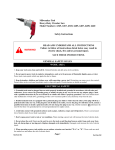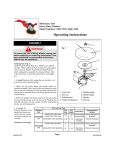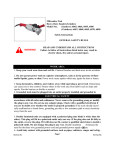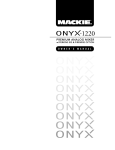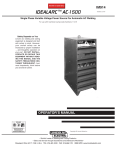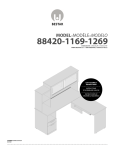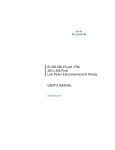Download Milwaukee Compound Miter Saw Operating instructions
Transcript
Milwaukee Tool Item: 10” Magnum® Compound Miter Saw Model Numbers: 6494 Operating Instructions SPECIAL FEATURES The MILWAUKEE Magnum® Compound Miter Saw is highlighted by the following unique product features: Unique Flip Fence System MILWAUKEE’s unique flip fence can be adjusted to two different positions: one position for miter cuts and one position for bevel & compound cuts. Typically, the fence system on compound miter saws provides excellent work support for compound miter cuts, but lacks support for general miter cuts. MILWAUKEE revolutionized a new fence system that provides superior work support for both compound and regular miter cuts. The flip fence features a quick-change slot, which makes adjustments simple. Bevel Mechanism with Overtravel The MILWAUKEE Magnum® Compound Miter Saw has a bevel mechanism that allows the bevel angle to be adjusted to 0° to 50° on the left and 0° to negative 3° on the right. The overtravel is provided by spring-loaded stops at 0° arid 45° with travels to a-3° right bevel and a 500 left bevel. This feature is useful for -making precise cuts. Longer Base Extension The longer base extension provides better support for the workpiece, especially for bevel cuts. The longer table also provides additional area for the operator to hold the workpiece during a cut, resulting in more accurate cuts. Detent Override The detent override, when engaged, allows the table to smoothly rotate to any miter angle. The table can be easily locked at any miter angle. It is especially useful when making small adjustments near 0°, 15°, 22.5° 30°, and 45°. CAPACITY CHART Compound 450 Miter & 450 Bevel Cuts 900 Miter & 450 Bevel Max. Height Max. Height Max. Width Max. Width 2-34/” W at 2-1/4” H 4” W at 1-13/16” H 4” W at 2-1/4” H 5-9/16” W at 1-13/16” H ASSEMBLY WARNING! To reduce the risk of injury, always unplug tool before attaching or removing accessories. Use only specifically recommended accessories. Others may be hazardous. Mounting the Miter Saw (Fig. 3) To prevent the tool from sliding, falling or tipping during operation, the saw can be mounted to a supporting surface such as a level, sturdy worktable or bench. Position the saw and workbench to allow adequate room for cross-cutting long stock. To mount the saw, insert fasteners through the four holes in the base of the saw. Fig. 3 CAPACITY CHART Miter Cuts Max. Height Max. Height Max. Width Max. Width at 90o at 45o 3-12” H at 3-7/8” W 3-12” H at 2-3/4” W RenTrain INC at 90o at 45o 5-9/16” H at 3-7/8” H at 2-1/2” W 2-1/2” W Page 1 1. Holes for mounting 1. RenTrain INC Operating Instructions (continued) Installing the Clamp Handle (Fig. 4) The Clamp Handle locks the selected miter angle. The tool is shipped with the handle unassembled. To install the handle, thread it clockwise into the tool as shown. To tighten the handle and lock the angle, turn the handle clockwise. To loosen and unlock, turn it counterclockwise. Fig. 4 gages. Use the supplied -wrench to loosen and remove the left-hand thread blade screw clockwise (wrench is stored behind the right fence in wrench holder). 3. Lift and hold the lower guard up. Remove the outer blade flange, blade (if present), and the inner blade flange. Wipe the flanges and spindle to remove dust and debris. . 4. Install the inner blade flange as shown: Match the arrow on the blade with the arrow on the tool casting. Then, install the selected blade by sliding the blade between the gap in the fence and then lifting the blade up to the spindle. Install the outer blade flange. 5. Press the spindle lock and rotate the blade until lock engages while replacing and securely tightening the blade screw counterclockwise with supplied wrench. Rotate the blade screw guard into position and securely tighten the two screws clockwise. 1. Holes for mounting Raising and Lowering the Saw Head (Fig. 5) The saw head locks down for transporting and storing the tool. The tool is shipped with the saw head locked down. To unlock it, gently press and hold the head down and simultaneously pull the lock pin out. To lock the head, gently press and hold the saw head down and then push the locking pin in. Fig. 5 6. Lower the saw head and check the clearance between the blade and the turntable. The blade should rotate freely. If the blade contacts the turntable, see “Adjustments” on page 9. Return the wrench to the wrench holder. To change blades, follow the procedure above. Fig. 6 1. 3. 2. 1. Blade screw guard 1. 2. Spindle lock 2. Fig. 7 1. Locking pin slides 2. Lock 1. 2. 1. Blade 2. Inner Flange Installing and Changing Blades (Fig. 6 & 7) Always use clean, sharp blades because dull blades tend to overload the tool, bind and cause pinching. Use only 10” blades rated at least 5500 RPM. 4. 3. Outer Flange 4. Blade Screw 1. To install a blade, unplug the tool. Raise the saw head. Loosen (do not remove) the two screws on the blade screw guard counterclockwise. 2. Rotate blade screw guard to expose blade screw. Press the spindle lock and rotate the blade until the lock enRenTrain INC Page 2 3. RenTrain INC Operating Instructions (continued) OPERATION Fig. 9 WARNING! 1. To reduce the risk of injury, always wear eye protection.. Always wait for the blade to stop completely before making adjustments or servicing the tool. Do not defeat the guards. Collecting Dust (Fig. 8) For dust collection, MILWAUKEE recommends using either Dust Bag or a MILWAUKEE Vacuum Cleaner. The dust tube is designed to accept a standard vacuum hose and swivels for convenience. Fig. 8 1. Upper Guard 2. Lower Guard 1. Dust Tube 2. guard is opened with the saw head in the up position, the saw head will not be able to be lowered. 1. Select the Workpiece Carefully Be cautious of pitchy, knottY, wet or warped stock. These materials are likely to create pinching conditions. Workpieces that bow and pinch may result in kick back. Inspect for and remove nails before cutting. Always keep blades clean and sharp; otherwise the blade produces a narrow kerf and is likely to be pinched by the workpiece. This tool is not recommended for cutting ferrous metals such as iron and steel. Using Face Boards There are holes in the fences for attaching face boards. Face boards place distance between the fence and the workpiece, providing improved support for some workpieces. For example, as the width of the face board increases, the height of the workpiece which can be cut increases slightly (but the width capacity decreases slightly). Similarly, if you place a face board on the saw table and place a workpiece on top of the face board, you can cut a workpiece with greater width (but with less height). Guards (Fig. 9) The tool is shipped with both the upper and lower guard installed. The lower guard should cover the blade when the saw head is up and it should open automatically as the saw head is lowered into the workpiece. If the lower guard appears loose or if it does not move to cover the blade when the saw head is up, take the saw to an authorized service center for repairs. Do not attempt to open the guard further than the automatic action permits. The tool is designed so that when the RenTrain INC Support the Workpiece Properly Always support the workpiece during operation. Otherwise, the workpiece may tend to pull-up and into the saw. While there are many ways to support and secure workpieces, MILWAUKEE advises using one of the following three methods. 1. Use the Fence: (Fig. 10) Align the workpiece flush against the fence as shown to provide a straight path for the saw blade. This will help eliminate the tendency for the blade teeth to bind. The fence can be used as a support for miter, bevel and compound cuts. 2. Use Vise No. 49-97-0110: (Fig. 11) Clamp the workpiece to the table using the MILWAUKEE vise as shown. The vise fits into the slot on the back of the left fence. Vise sold separately. 3. Use a C-clamp: (Fig. 12) Clamp the workpiece to the fence with a C-clamp as shown. Page 3 RenTrain INC Operating Instructions (continued) Adjusting the Miter Angle (Fig. 13) The saw cuts miter angles from 51° on the left to 59° on the right. Angle markings appear on the scale that runs along the perimeter of the base as shown. Nine angles are pre-set with positive angle stops: 0° 15°, 22.5°, 30°, and 45° on both the left and right side of the table. Fig. 10 1. To select a positive angle stop, be sure the clamp handle is loosened. Press the angle stop lever and rotate the turntable to the desired angle. Tighten the clamp handle. Supporting the workpiece against a fence during a compound cut. 2. To select other angles, the saw features an override mechanism, which allows quick and accurate adjustments at any angle. To use the override, press the angle stop lever down and in with your thumb until the lever engages with the lever lock. Then rotate the turntable to desired angle. Tighten the clamp handle securely clockwise. This feature is particularly useful when making small adjustments near positive angle stops. Fig. 11 Fig. 13 1. Miter angle scale Supporting the workpiece with a vice. 1. 2. 3. 2. Positive angle stop 3. Lever lock Fig. 12 4. Angle stop lever 4. Supporting the workpiece with a C-clamp.. Adjusting the Bevel Angle (Fig. 14 & 15) The bevel mechanism has twit positive spring-loaded stops: one at 0° and one at 45°. The mechanism can be adjusted to any angle in between by using the bevel angle scale, shown at the rights The bevel mechanism has several degrees of overtravel on both the left and right; the saw can be adjusted to 50° RenTrain INC Page 4 RenTrain INC Operating Instructions (continued) on the left and to negative 3° on the right. To obtain the. overtravel, apply several pounds of force on the saw handle to override the spring-loaded stops. Do not attempt to exceed the stated overtravel. 1. To adjust the bevel angle, place one hand on the front handle for better control. Using the other hand, loosen the bevel adjustment lever ,(clockwise if standing behind the tool; counterclockwise if standing in front of tool). 2. Pull or push the saw handle to desired position, using the bevel angle scale as a guide. 3. Tighten the bevel adjustment lever securely (clockwise if standing behind tool; counterclockwise if standing in front of tool). The tool is shipped so that the blade is square to the turntable. If the blade becomes misaligned, it can be realigned using two socket head cap screws. 1. With the bevel angle adjusted to 0°, place one edge of a 90° square against the turntable and the other edge of the square against the saw blade. If the blade is not square, use a hex wrench to loosen or tighten the socket head cap screw A (Fig. 16) until the blade is square. 2. Once the blade is square, check to see if the bevel scale pointer is=at 0°. If it is not, use a wrench to loosen the pointer screw and move the pointer to 0°. 3. Tilt the saw to a 45° bevel. Verify that the pointer reads 45°. If it does not, loosen or tighten the socket head cap screw B (Fig. 17) until the pointer reads 45°. Fig. 14 1. Bevel angle scale Fig. 15 Fig. 16 1. Socket Head Cap Screw A 2. Pointer Screw 3. Pointer 1. 1. 1. 2. 3. Fig. 17 1. Bevel adjustment lever 1. RenTrain INC Page 5 1. Socket Head Cap Screw B RenTrain INC Operating Instructions (continued) Using the Flip Fence (Fig. 16-18) The saw features a flip fence which can be positioned for regular miter cuts and for compound cuts as shown. This feature helps to provide superior support for both types of cuts. Fig. 20 1. Fence is in the miter position. 3. With the fence lock lever parallel with the fence, insert the fence lock lever through the fence slot. Then, turn the fence lock lever securely clockwise to secure the fence to the tool. Fig. 18 1. Fence lock lever NOTE: Verify that the clamp on the mechanism has rotated to a vertical position 90° to the slot. This position is required for proper clamping. 1. To adjust the fence, turn the fence lock lever counterclockwise to loosen it. When the fence lock lever is parallel with the fence slot, pull the fence away from the saw. A firm detent must be overridden to accomplish this. 2. Position the fence for the desired cut. The photos shown illustrate the proper fence position for miter cuts (Fig. 20) and for compound cuts (Fig. 19). Always be sure to position the fence properly for maximum work support. Fig. 19 Starting and Stopping the Tool Always hold the handle firmly because the starting and stopping action of the motor may cause the handle to move up or down slightly. Always secure the turntable by tightening the clamp handle when setting miter angles (see “Adjusting the Miter Angle” and “Adjusting the Bevel Angle” on page 4). Always make sure the spindle lock is released so the blade is free to rotate. To start the motor, pull the trigger. To stop the motor, release the trigger. Electric Brake The Miter Saw features an electric brake. The brake engages when the trigger is released, causing the blade to stop and allowing you to proceed with your work. Generally the saw blade stops in four to five seconds. However, there may be a delay between the time the trigger is released and the time the brake engages. Occasionally the brake may miss completely. If the brake misses frequently, the saw needs servicing by an authorized MILWAUKEE service station. The brake is not a substitute for the guards, so it is essential to always wait for the blade to stop completely before removing the blade from the kerf. The correct brush grade must be used for proper operation of the brake. Use only identical MILWAUKEE replacement brushes when servicing the tool. Fence is in the compound cut position. RenTrain INC Page 6 RenTrain INC Operating Instructions (continued) Making a Cut 1. Plug in the tool. Raise the saw head completely. WARNING! To reduce the risk of injury, do not rely on the brake as a safety feature. Always wait until the blade stops completely before allowing anything near the blade. 2. Select the desired angle following the steps in “Adjusting the Miter Angle” and “Adjusting the Bevel Angle” on page 4. Cutting the Kerf Plate Slot (Fig. 21) The tool is shipped with the kerf plate installed; never attempt to make a cut without the plate installed. The kerf plate is NOT factory cut, so the first cut you make with the tool will be to create a kerf slot. The angle of the kerf slot for compound cuts is different than that for miter cuts. Therefore, it is necessary to cut new kerf slots for each type of angle. Generally, it is best to cut a kerf slot before cutting a workpiece. 3. When cutting a kerf slot, be sure to use the blade you intend to use for your work since blades have different widths that affect the kerf. When changing from a thick blade to a thinner one, you may want to purchase a new kerf plate and cut a new kerf slot. Also, bevel cuts require a different kerf slot than miter cuts, so always be sure to cut a new slot for bevel cuts. Cut the kerf slot following the procedure below. 1. To cut a kerf slot, plug in tool and hold handle firmly. 2. Start the motor following the instructions on page 6. 3. Wait a few seconds for the blade to reach full speed. Place the workpiece on the turntable and line up the cut. 4. Support the workpiece using any of the methods described in “Support the Workpiece Properly” on page 3.. 5. Start the motor following the instructions on page 6. Wait a few seconds for the blade to reach full speed. Then gently lower the saw head into the workpiece all the way through the cut. 6. Always allow the saw to do the work. Forcing the tool may stall or overheat the motor. 7. After the cut is complete, release the trigger and wait for the blade to stop completely. Then gently raise the saw head and remove the workpiece. Always unplug the tool before retrieving loose cut-off pieces from inside the guard area. Lock-Off Feature (Fig. 22) 4. To help prevent damaging the kerf plate, gently and slowly lower the saw head to the full depth of cut (the point where the head will not lower any further). When the cut is complete, release the trigger. WAIT FOR THE BLADE TO STOP COMPLETELY before gently raising the saw head. To alter the depth of cut; read “Adjusting the Depth of Cut” on page 9. There is a hole in the trigger through which a padlock will fit to lock the tool when it is not in use. Use a padlock with a 1/4” shackle and always unplug the tool before installing it (padlock not supplied with tool). 1. Trigger with hole for padlock 1. Fig. 22 Fig. 21 1. Kerf slot 2. Kerf plate RenTrain INC 1. 2. Page 7 RenTrain INC Operating Instructions (continued) Applications Cutting Compound Miters (Fig. 23 & 24) Fig. 23 identifies miter and bevel settings for various types of crown molding for 90° corners. Note that these are-ideal settings and may vary because many moldings have slightly different spring angles and some walls are not perfectly square. If the wall or ceiling is bumpy, the miter angle will not hold true, so the bumps may need to be sanded. Fig. 24 illustrates the relationship between the spring angle, the ceiling, the wall and the molding. Fig 23. Angle Settings for Compound Saw (for 900 corner) Type of Crown (spring angle) Miter Miter (angle of table) (angle of blade) 300 350 380 400 450 520 26.60 29.80 31.60 32.70 35.30 38.20 37.80 35.40 33.90 32.80 30.00 25.80 Positioning Crown Molding on The Saw (Fig. 25 & 26) Determining how to lay a workpiece on the miter saw table for cutting molding can be tricky for even the experienced woodworker. Figs. 25 & 26 and these instructions serve as a guideline. The wood labeled A, B, C & D in Fig. 25 are the four pieces of wood that form an inside and an outside corner. Each piece of wood has: a “top” edge, which is against the ceiling a “left” or “right” name a “face,” which is the visible surface z z z Fig. 26 illustrates three different views of wood pieces A, B, C & D. Wood A1, 131, C1 & D1 shows the wood lying flat on a table. Dashed lines on the wood pieces indicate that the bevel is “hidden”, meaning it is on the underside of the wood. When the inside corner woods Al and 131 are lying flat on a table, the bevel faces are exposed (i.e. on top). However, when the outside corner woods C1 and D1 are lying flat on a table, they have “hidden” bevel faces, meaning the bevel angle is on the underside of the. wood. Wood pieces A2, A3, B2, B3, C2, C3, D2 and D3 illustrate A, B, C, & D lying on the miter saw table both face up and face down as indicated. Using these illustrations as a guide, it is easy to determine how to lay the wood against the miter saw fence and how to set the miter and bevel angle for a compound cut. Wood is positioned flat on the miter saw table. Inside Corner Outside Corner Fig. 25 Fig. 24 e Crown Molding Profile 1. Top Left Face Top Right Face p c Tot Fa gh Ri p e To Fac ft Le Blade Kerf Here Blade Kerf Here A1 Top Left Face 3 Top B1 Right Face C1 A3 poT ecaF tfeL C2Left Face Top Miter Saw Fence Miter Saw Fence A2 Top Left Face * * Miter Saw Fence Top Right Face B2 D1 Top Right Face Top Left Face Right Face B3 Top * Top Left Face 2. Miter Saw Fence D2 poT ecaF thgiR * Top D3 Right Face Face Up Face Up z 1. Ceiling 2. Wall 3. Spring Angle C3 These workpieces are Face Down. Face down cuts can be used in special cases, depending on the type of crown molding. Inside Corner Blade kerf here Outside Corner Miter saw fence Top left face Face up Top right face RenTrain INC Page 8 RenTrain INC Operating Instructions (continued) Adjustments Fig. 25 1. Adjusting the Fences The left fence is fastened to the Miter Saw with three screws and the right fence is attached with two screws. The tool is shipped with the fences aligned and square. If the screws loosen, the fences may lose its alignment, possibly resulting in inaccurate cuts. 1. To realign the fences, unplug the tool. Adjust the miter and bevel angles to 0°. 2. Place a square flat on the saw table as shown with one edge along the left fence and the other edge along the blade. The left fence should be perfectly perpendicular to the blade. If it is not, loosen the three screws fastening the fence to the tool. Then slide the left fence until it is square to the blade. Securely tighten the three screws. 1. Depth adjustment screw with lock nut 3. After the left fence is aligned, use a straight edge to align the right fence to the left fence. Then make a sample cut and adjust as necessary. Verify that the pointer is at 0°. To adjust the depth of the depth adjustment set screw, slightly raise the saw head to reduce the depth of cut or slightly lower the saw head to increase the depth of cut. Make only a SLIGHT adjustment. Adjusting the Depth of Cut (Fig. 25) 1. To adjust the depth of cut, unplug the tool. Loosen (counterclockwise) the lock nut located on the back of the tool as shown. 2. To adjust the depth of the depth adjustment set screw, slightly raise the saw head to reduce the depth of cut or lightly lower the saw head to increase the depth of cut. Make only a slight adjustment. 3. Securely tighten the lock nut. 4. Make a sample cut and adjust as necessary. RenTrain INC Page 9 RenTrain INC









